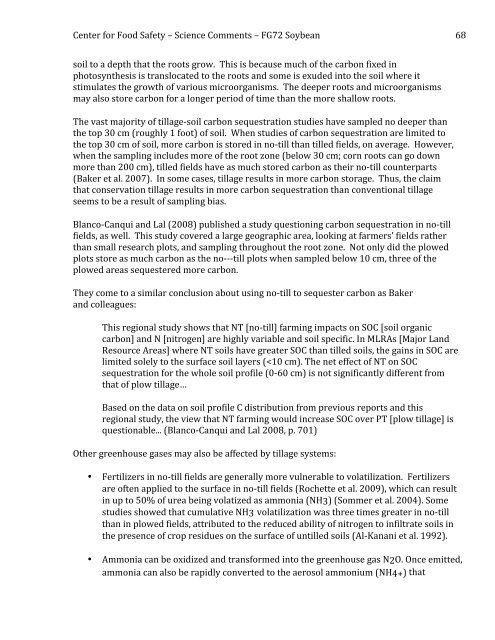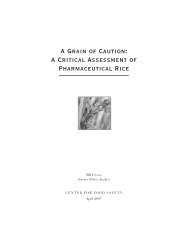a four-fold rise - Center for Food Safety
a four-fold rise - Center for Food Safety
a four-fold rise - Center for Food Safety
Create successful ePaper yourself
Turn your PDF publications into a flip-book with our unique Google optimized e-Paper software.
<strong>Center</strong> <strong>for</strong> <strong>Food</strong> <strong>Safety</strong> – Science Comments – FG72 Soybean <br />
68 <br />
soil to a depth that the roots grow. This is because much of the carbon fixed in <br />
photosynthesis is translocated to the roots and some is exuded into the soil where it <br />
stimulates the growth of various microorganisms. The deeper roots and microorganisms <br />
may also store carbon <strong>for</strong> a longer period of time than the more shallow roots. <br />
The vast majority of tillage-‐soil carbon sequestration studies have sampled no deeper than <br />
the top 30 cm (roughly 1 foot) of soil. When studies of carbon sequestration are limited to <br />
the top 30 cm of soil, more carbon is stored in no-‐till than tilled fields, on average. However, <br />
when the sampling includes more of the root zone (below 30 cm; corn roots can go down <br />
more than 200 cm), tilled fields have as much stored carbon as their no-‐till counterparts <br />
(Baker et al. 2007). In some cases, tillage results in more carbon storage. Thus, the claim <br />
that conservation tillage results in more carbon sequestration than conventional tillage <br />
seems to be a result of sampling bias. <br />
Blanco-‐Canqui and Lal (2008) published a study questioning carbon sequestration in no-‐till <br />
fields, as well. This study covered a large geographic area, looking at farmers’ fields rather <br />
than small research plots, and sampling throughout the root zone. Not only did the plowed <br />
plots store as much carbon as the no-‐-‐-‐till plots when sampled below 10 cm, three of the <br />
plowed areas sequestered more carbon. <br />
They come to a similar conclusion about using no-‐till to sequester carbon as Baker <br />
and colleagues: <br />
This regional study shows that NT [no-‐till] farming impacts on SOC [soil organic <br />
carbon] and N [nitrogen] are highly variable and soil specific. In MLRAs [Major Land <br />
Resource Areas] where NT soils have greater SOC than tilled soils, the gains in SOC are <br />
limited solely to the surface soil layers (







